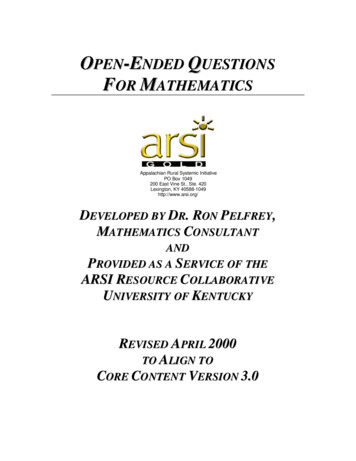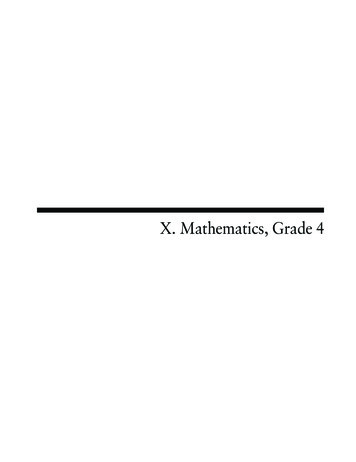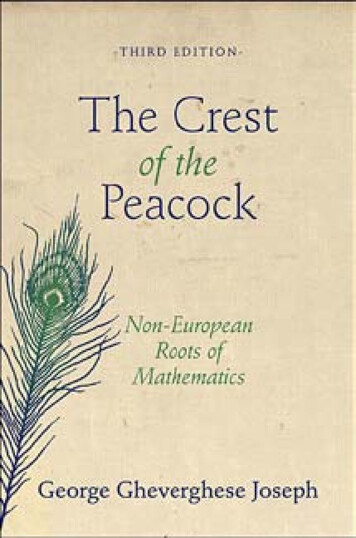
Transcription
5th International Symposium 2015 – IntSym 2015, SEUSLTHE ROLE OF MATHEMATICS IN BIOLOGYP. ElangoDepartment of Mathematical Sciences, Faculty of Applied Sciences, South EasternUniversity of Sri Lankaelango@seu.ac.lkABSTRACT: Mathematics plays a key role in many disciplines of science, primarily as amathematical modeling tool. New innovations and developments in physics are by the influenceof mathematics. Calculus was invented entirely for the use of physics. The importance of the roleof mathematics in physics is understood by the existing discipline “mathematical physics” or"theoretical physics". One can think is mathematics has that same important role or even lesserimportant role in the field of biology and is mathematics and biology could possibly haveanything in common. Even though physics and biology are very different sciences,mathematicians and biologists developed the "mathematical biology" or "biomathematics" as arecent discipline for the mathematical representation in biology to the theoretical and practicalapplications in biological, biomedical and biotechnology researches. In this paper we study therole played by mathematics in biology and analysis weather a considerable amount ofmathematics courses need to be teach for biological science graduates.Keywords: Mathematics, Biology, Mathematical models, Biomathematics.1. INTRODUCTIONIn early days an attempt was made to establish the mathematical biology as a newdiscipline, but it did not succeed (Keller,2002). There were initiatives bymathematicians but there were no precedents. For example, theoretical models todescribe the spread of diseases had been discussed by Bernouilli and the flow ofblood in veins was the uppermost in Euler’s mind when he performed his seminalwork on fluid mechanics (Euler,1775).Mathematical biology or biomathematics is a fast-growing well-recognized and themost exciting modern application of mathematics. This is an interdisciplinaryresearch area with a range of applications in biology, biotechnology and biomedicalscience. The filed may be referred to as mathematical biology or biomathematics tostress the mathematical side or theoretical biology to stress the biological side. Avariety of mathematical techniques are used in mathematical biology to modelbiological researches. Mathematical areas such as calculus, probability theory,statistics, linear algebra, graph theory, combinatorics, algebraic geometry, topology,dynamical systems, differential equations and coding theory are now being appliedin this field.215
5th International Symposium 2015 – IntSym 2015, SEUSLMany topics from biosciences have been high priority on the global agenda; thefights against cancer and degenerative diseases of the brain, such as Alzheimer’s,Parkinson’s and ALS and the management of health threats such as AIDS. Societyis waiting to get the research results for their better life. The emergence of modelsand the existence of large data sets that require quantitative analysis in biologygives a great opportunity for mathematics. The existing or already establishedmethods in mathematics can be used to support biological problems but thequantitative analysis of the fundamental problems in bioscience definitely requirenew ideas and new techniques from mathematics. The most significant biologicalachievement of the 20thCentury is the identification of the DNA. This work wasessentially done by Physicists, Chemists and Crystallographers. There has alreadybeen evidence of effective contribution between biology and mathematics. Forinstance, the modeling of epidemics and the study of signal propagation in nervesare the growing works of differential equations and studies of dynamical system inthis century.There are several biomathematics research groups already established in thedepartments of mathematics, statistics, computer science and biology and alsobiostatistics centers around the world. The current size of the mathematicalbioscience research groups and researchers is relatively small compared theimportant and need of mathematics for biological sciences.2. THE ROLE OF MATHEMATICS TO BIOLOGYMathematical biology or biomathematics is a fast growing, well recognized and themost exciting modern application of mathematics. The use of mathematics inbiology is important since biology becomes more quantitative. This new disciplinehas applications in biology, biomedical and biotechnology. The aim of this newdiscipline is the mathematical representations and modeling of the biologicalproblems using a variety of mathematical theories and techniques. Themathematical biology has both theatrical and practical applications in research onbiological, biomedical and biotechnological fields.One significant work is currently done by Dr. Aver Friedman, distinguishedProfessor of mathematics and his research team at the Oberlin center forcomputation and modeling in Ohio State university is to find a cure for cancer(Margaret Putney, 2005). The objective of the research is to use a virus that attacksjust the tumor while leaving the healthy cells alone. The cancer which mostlyaffected by research is a particular type of brain tumor known as glioma. Theresearchers are trying to find a virus that reproduces fast enough is able to avoidenough of the immune system to reduce the tumor. The researchers of this centerfound some parameters that would cause the tumor to be reduced. They passedtheir result to the biologists to create a virus that matches such parameters.216
5th International Symposium 2015 – IntSym 2015, SEUSLAnother contribution of mathematics to biology is a mathematical modeling toaddress the biological process. The Mathematical Biosciences Institute in OhioState university works on this work. The institute works on the explosion ofbiological data which was created by the technology to study biological systems.The data created a need to develop many mathematical models, statistical methodsand computational algorithms. The mathematical models needed to encompass thebiological process such as neurological and cellular problems. In neurologicalprocess, Parkinson’s disease is in the center of the modeling work. There arearound 1012 neurons in the human brains. To understand properly their relationshipwith all of the other neurons they proved that the differential equations can be usedfor the models.Ecology and evolutionary biology are the dominant fields of mathematical biology.Evolutionary biology has been the subject of extensive mathematical theorizing.Hanna Kokko, theatrical biologists and the professor in the department of biologicaland environmental science at the University of Helsinki says that much of biologyrelies on mathematics (Hanna Kokko, 2007).Evolutionary ideas are often complexand the logic of hypothesis proposed should be tested not only empirically but alsomathematically.Another area of specialized research in mathematical biology is the genetic modelsand various models of the spread of infections. Cancer modeling and simulation,modeling the movement of interacting cell populations, mathematical modeling ofthe cell cycles are some of the models developed in the discipline of mathematicalbiology. Molecular set theory was introduced by Anthony Bartholomay. Molecularset theory is a mathematical formulation of the chemical kinetics of bio-molecularreactions in terms of sets of molecules and their chemical transformations. Itsapplications were developed in mathematical biology and especially in mathematicalmedicineMany universities in the western countries offers degrees in the field ofbiomathematics such as University of St Andrews offers B.Sc. (Hons) in Biology andMathematics, University of Dundee offers B.Sc.(Hons) in Mathematical Biology,University of Leeds offers B.Sc. in Biology and Mathematics and University of Yorkoffers M.Sc. in Advanced Mathematical Biology. These courses consists bothmathematics and biology subjects. There is a need to offer a considerable amountof mathematics courses for biology graduates and biology courses for mathematicsgraduates in Sri Lanka to work in the field of biomathematics.3. METHODOLOGYWe examine some biological models in which mathematics played major role on theproblem. There are more models already developed in biomathematics but we looktwo simple models for our examination.217
5th International Symposium 2015 – IntSym 2015, SEUSLIschemic WoundsChronic wounds represent a major public health problem worldwide. To determinetherapeutic strategies which help to heal ischemic wounds, a mathematical modelwere developed by Xue, Friedman and Sen (Avner Friedman, 2010). In thismodeling process, a full thickness bipedicle dermal flap was developed first toisolate the blood supply from underneath the flap and from two long edges. Onecircular wound was developed in the center of the flap (ischemic wound) andanother on the normal skin (nonischemic wound). The main variables involved in thewound closure phase of the healing process are several types of blood and tissuecells, chemical signals and tissue density. The model was formulated by using thesystem of particle differential equations in a partially healed domain.Figure 1 shows the parts of the wound for modeling. The open wound is the circularregion( ), the partially healed wound is the annulus ( )( ) andthe normal healthily tissue is the region ( ). They assumed that the woundis circular but small incisions of size are made at the boundarywith adjacentincisions separated by distance . Takingand applying the homogenizationtheory, each boundary condition. The derived model is()()Here is a measure of ischemia; near 1 means extreme ischemia. These resultsare agreement with the experimental results. The model now can be used as a toolto suggest biologically testable hypotheses for improved healing. So this reducesthe need for guesswork and time-consuming animal testing.normal- intervalPartially healed- intervalWoundR(t)LLLR(0)Figure 1. Ischemic Wound218
5th International Symposium 2015 – IntSym 2015, SEUSLEpidemic modelsThe study of epidemics has come up with an astonishing number and variety ofmodels and explanations for the spread and cause of epidemic outbreaks (Perelsonet al., 1996). A simple but experimentally based model, proposed by Ho et al.(Murray, 2002) for viral production and viral decline was a simple linear first orderequation which accounted for viral production and viral decline:Where represented a source of viral peptides and was the viral clearance rate.While many factors play a role in the clearance of viral peptides such as immunecells, fluid flow and absorption into other cells, c did not distinguish between them.After introduction of the protease inhibitor (the specific type of drug used on thepatients) it was assumed that the drug would be completely effective. This meansthe drug would block all viral production after being introduced. Hence.Therefore, we get the modelWhich implies that,( )Whereis measured as the mean viral concentration in the plasma before thetreatment. Due to these models developed by Ho et al. many more models havebeen developed to the study of HIV.We can develop four specific models which includes an equation for uninfected Tcells, T, productively infected T-cells, T*(not all infected T-cells produce the virus),infectious viruses, V1, and noninfectious viruses, VN1. The model consists of thefollowing equations:()()()219
5th International Symposium 2015 – IntSym 2015, SEUSLIn the T-cell equation, it was considered the cells destroyed proportional to thenumber of infected viruses and cells with clearance parameter k. In the absence ofinfection there is a nonzero steady state,. The value for the constants can becalculated by the patients database. Some models have assumed that the T-cellsdo not change dynamically during the first weeks of treatment and hence we set, a constant. However, after antiretroviral therapy is initiated some recoveryof T-cells is observed and patient data presented by Ho et al (Ho et al., 1995)suggested that over a period of weeks the recovery of T-cells can be described byeither a linear or exponential function of time with no statistically significantdifference between the two functions over that time period. T-cells replacement canbe due to the source s, which incorporates the generation of new cells in the thymusor to proliferation of cells. If source s is the major mechanism of T-cell replacement,we can then approximate the T-cell dynamics byor equivalently( )whereis a constant.More analysis can be done through these models and can develop more accuratemodels using the biological concepts and mathematical theories. Development ofmore accurate models need the knowledge in both biology and mathematics. Onesubject knowledge is not sufficient as this is a practical biological problem which canbe solved mathematically.Biological waves: single-species modelsThere is a vast number of phenomena in biology in which a key element to adevelopmental process seems to be the appearance of a travelling wave ofchemical concentration, mechanical deformation, electrical signal and so on. Thewidespread existence of wave phenomena in the biomedical sciences which requirethe study of travelling waves in depth and of the modeling and analysis involved ismentioned in many places. For example, the introductory text on mathematicalmodels in molecular and cellular biology edited by Segal (Segal, 1980) deals withsome aspects of wave motion. Estimation of diffusion coefficients for insectdispersal in interacting populations in now studied with care and supplication.The standard diffusion equation in one space dimension, is of the form220
5th International Symposium 2015 – IntSym 2015, SEUSLwhereis the diffusion coefficient. When reaction kinetics and diffusion arecoupled, travelling waves of chemical concentration exists and can effect abiochemical change very much faster than straight diffusion process given by( )whereis the concentration, ( ) represents the kinetics andis the diffusioncoefficient. This model further developed in the areas of ecology and developmentalbiology which belong to important areas where modeling has played a significantrole.4. RESULTS AND DISCUSSIONThe above example models show the role played by mathematics in biologicalproblems. They clearly indicated that a deep knowledge in both mathematics andbiology is very important for the development of realistic models. A Continuousdiscussion between biologist and mathematicians is also needed during themodeling process. When the models are formulated by mathematicians, they will bepassed to biologists for testing in real situations. During the testing process, factorsinvolved in the problem will be examined using the model and patient data. So thefactors will be evaluated using the patient data and model and compared. Anyassumptions made during the modeling process will also be tested with patient dataor realistic conditions. Improvement suggestions will be passed from biologists tomathematicians for development of better models. This process will continue for anumber of cycles until a better model is formulated by both biologists andmathematicians. We should note that when biologists pass their requirements tomathematicians, the mathematicians should have knowledge in biology tounderstand the biologists' request. Similarly, when the mathematicians developed amodel, the biologists should have mathematics knowledge to understand the model.It clearly shows that knowledge in both mathematics and biology is very important tosolve biological problems. This also indicated the importance of a discipline which isa combination of mathematics and biology. Since this new discipline deals with realproblems and solve them in a realistic way, this new discipline, biomathematics,becomes popular among biologist and mathematicians.5. CONCLUSIONThe great alliance between mathematics and physics is well recognized universally.Both disciplines are supporting each other. There are areas in biology which haveadvanced by mathematics, such as computational neuroscience, populationdynamics, ecology, spread of disease and phylogenomics. In future, themathematics will be the future frontier of biology and biology is the future frontier of221
5th International Symposium 2015 – IntSym 2015, SEUSLmathematics. Considering this new trend, important mathematics courses should beincluded in biology curriculum to understand the applications of mathematics andalso a considerable number of biology courses should be included to mathematicscurriculum to understand the biological problems.The new discipline,biomathematics, should be introduced in our undergraduate and postgraduatecurriculum to produce our graduate with the latest research knowledge in biologicalstream.6. REFERENCESAVNER FRIEDMAN (2010) What is mathematical biology and how useful is it?Notices of the AMS, pp. 851-857.EULER. L. (1775) Principia pro motosanguinis per arteriadeterminando. Quoted inS. J. Sherwin, V. Franks, J. Peiro and K. Parker, One-dimensional modelling of avascular network in space-time variables, J. Eng. Math., 47 (2003). pp. 217-250.HANNA KOKKO (2007) Modelling for Field Biologists and Other Interesting People,Cambridge University Press.KELLER. E. F. (2002) Making sense of life: explaining biological developments withmodels, metaphors and machines, Harvard University Press, Cambridge.MARGARET PUTNEY (2005) Mathematics Biology ?, The Oberlin Review.MURRAY. J.D. (2002) Mathematical Biology-I An Introduction, InterdisciplinaryApplied Studies, Vol.17, Springer.PERELSON. A.S., NEUMANN. A.U., MARKOWITZ. M, LEONARD. J.M, and HO.D.D. (1996) HIV-1 dynamics in vivo: Virion clearance rate, infected life-span andviral generation time, Science, 271. pp. 1582-1586.HO. D.D, NEUMANN. A.U., PERELSON. A.S, CHEN. W, LEONARD. J.M, andMARKOWITZ. M, (1995) Rapid turnover of plasma virions and CD4 Iymphocytes inHIV-1 infection, Nature, 373, pp. 123-126.SEGAL. L.A., editor. (1980) Mathematical Models in Molecular and Cellular Biology,Cambridge University Press.222
applications in biological, biomedical and biotechnology researches. In this paper we study the role played by mathematics in biology and analysis weather a considerable amount of mathematics courses need to be teach for biological science graduates. Keywords: Mathematics, Biol










